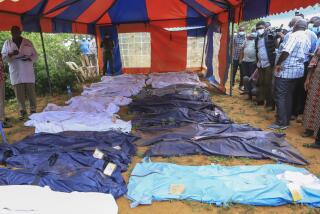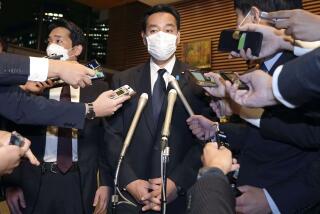Evidence Against Cult Fabricated, Japanese Guru Testifies
- Share via
TOKYO — A defiant Shoko Asahara, leader of the Aum Supreme Truth cult accused of last year’s deadly gas attack on Tokyo’s subways, insisted at a legal hearing Wednesday that the evidence against his sect is fabricated.
Speaking under tight security at a jailhouse hearing on whether his group should be banned as a subversive organization, Asahara, 41, said his followers are peaceful and pose no threat to society, and he called on fugitive members of the sect to surrender.
Supreme Truth “will never violate the law nor commit subversive activities, and I have no intention of ordering such acts,” said the longhaired, full-bearded and nearly blind Asahara. “Ordinary people can understand we’re not dangerous. . . . The evidence presented by the public security people is fabricated.”
Over the past year, police have collected massive physical evidence and many confessions linking the Supreme Truth organization to the subway attack, which killed 11 people and left more than 5,500 afflicted by sarin nerve gas. A 12th person believed to have been affected by the gas died of an apparent heart attack.
The cult has already been stripped of its status as a religious group and declared bankrupt. But evidence introduced at Wednesday’s hearing showed that the group still counts about 7,000 followers in Japan, about 500 of whom live at sect centers, including its main base in the village of Kamikuishiki near the foot of Mt. Fuji.
Justice Ministry lawyers told the hearing that the sect has collected about $640,000 in donations in 1996.
Wednesday’s hearing was part of a legal procedure, separate from Asahara’s trial, through which the government is seeking to ban the Supreme Truth organization under a 1952 anti-subversion law originally aimed at radical leftist organizations. The law has never been used for that purpose, and some Japanese civil libertarians oppose its attempted use against Asahara’s group as a dangerous precedent.
The government, however, argues that the sect not only carried out violent actions in the past but may do so again. It has accused Supreme Truth of plotting to overthrow the Japanese government and set up a “kingdom” under Asahara. A decision on whether to ban the group will be made by a panel appointed by the prime minister, based on evidence at the series of hearings. One or two more hearings are expected.
*
At the first hearing of his trial on murder charges last month, Asahara, whose real name is Chizuo Matsumoto, refused to enter a plea but gave a rambling statement. His statements Wednesday were the most extensive public defense of the cult he has made since his arrest a year ago.
But at the same time Wednesday, he withdrew his prophecy, previously made in cult literature, of vast destruction of Japan and much of the rest of the world in a 1997 Armageddon. “The process of Armageddon finished when Israeli Prime Minister [Yitzhak] Rabin was assassinated in early November 1995,” Asahara declared.
About 1,000 police and security officers stood guard at the Tokyo Detention House for the hearing, held in an administrative building room that had all its windows covered with steel sheets.
Asahara, wearing a blue prison jacket, loose white trousers and slippers, complained that he had not been given enough information about two previous hearings on the issue and called the process a mockery of justice. “With this hearing, they are trying to put me, someone who is blind, into a bag and give me a beating,” he said.
Asahara also denied a government allegation that his sermons had motivated followers to stage a deadly sarin gas attack in June 1994 in the central Japanese city of Matsumoto that killed seven people.
In advancing his argument that the existence of the Supreme Truth organization does not pose a threat to Japan, Asahara said he would not want believers to try to spring him from prison. There are some fears in Japan that Supreme Truth members might try to use terrorism or hostage-taking to free Asahara.
Serving time in jail is “my great chance to meditate,” Asahara said. “I don’t want anybody to take it away from me.”
More to Read
Sign up for Essential California
The most important California stories and recommendations in your inbox every morning.
You may occasionally receive promotional content from the Los Angeles Times.










